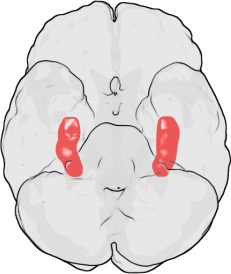Frozen in time
Our memories are thoughts and experiences frozen in time for later use. Organisms evolved their ability to preserve past experiences, especially those related to reward/punishment outputs, because this offered them an advantage in surviving and reproducing.
There are patients whose focal epileptic crises located in the hippocampus manifests through a panoramic view of one’s life during the crisis; although the hippocampus is also the main location responsible for Alzheimer”s symptoms, it is not the only place in our brain that stores data.
 The hippocampus. From Wikipedia
The hippocampus. From Wikipedia
The human memory can be:
I. declarative/explicit
– it allows us to preserve facts and events
– it is located in the hippocampus, the medial part of the temporal lobe, the diencephalon
II. non-declarative/procedural/implicit – it preserves “how to/algorithms”
– behavioral (abilities, customs) – located in the striatus, motor cortex, cerebellum
– identification/detection – located in the neocortex
– basic associative learning: emotional outputs (located in the limbic system) and muscular outputs (located in the cerebellum)
– non-associative learning – located in the reflex arcs
What is the importance of all these, you may ask? Memories are what define us in the end.The human memory is not reliable like that of a computer, but it still represents a continuum between our different stages in time.
As technology advances, so does our definition of death. A patient that is intubated and has a heart pacemaker – so can’t breathe nor maintain a heart beat on its own- can’t be legally declared dead unless one’s own brain is dead. This is equaled to total irreversible cerebral ischemia.
Yet we know that we temporarily lose our consciousness during sleep every night – not to mention anesthesia or hypothermia – and yet we preserve our personal identity because our memories are still there.
This is how a new definition of death appeared – the information-theoretical death:
“A person is dead according to the information-theoretic criterion if their memories, personality, hopes, dreams, etc. have been destroyed in the information-theoretic sense. That is, if the structures in the brain that encode memory and personality have been so disrupted that it is no longer possible in principle to restore them to an appropriate functional state, then the person is dead. If the structures that encode memory and personality are sufficiently intact that inference of the memory and personality are feasible in principle, and therefore restoration to an appropriate functional state is likewise feasible in principle, then the person is not dead.”
(Ralph Merkle, Molecular Repair of the Brain)
This definition is still not accepted legally today but it can be in the future.
For the moment, we can’t transfer but pieces of our memories to other data storing devices – we can do this by writing, photography, sound or video recording onto stones/papyrus/paper/computers and by talking influencing others’ behavior; yet no human being can “download” one’s whole mind at a certain moment and neither can one “upload” it back or to a different hardware.
The difference between the same piece of information located in a book and in one’s brain is that the biological hardware can use this information (which is a different process than the simple retrieval of data) as it has consciousness. Unless we will find a replacement for the neuron programmed to decay, our knowledge and lives will be limited by the cerebral definition of death.
leave a comment